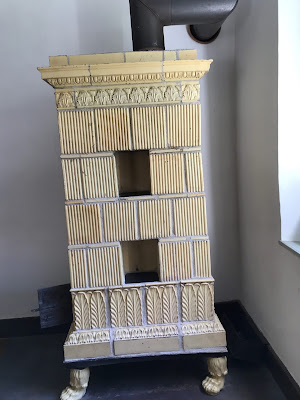The object of the NSCAC is to promote history and patriotism among young people. Our members all claim descent from someone who contributed to the 13 colonies prior to the revolution. Every year, our Geneal Assembly is held with that in mind.
We began by touring Old Salem - a living reconstruction of an early Moravian settlement in North Carolina. The Moravians were a religious group who originated in Germany and traveled to Pennsylvania, then south to North Carolina. Old Salem was intended to be a trade center for surrounding towns. All of the buildings there are original 18th & 19th century buildings, and many have interpreters inside to explain the various trades that took place there. One interpreter explained how women wore colored ribbons to designate their status - such as child, teen, single sister (young women of marrying age), married women and widows.
We visited the gunsmith shop and saw them making flint lock and pressure rifles.
Next was the Tavern which was a popular stop for "strangers" who visited the town to conduct visits. Even George Washington stayed there for 2 days in 1791. The cost of 1/2 bed for a night was equivalent to several days wages for many. There was a bar that served alcohol, and games of "skill" (not chance) for entertainment.
Down the street were the shops of the turner and the joiner, where we learned how their furniture was made by hand. Everyone got to try their hand at some of the tools. All of the wood shavings were recycled to fill in ruts in the road or start cooking fires.
At the silversmith shop, one attraction was a tile stove. We learned how the molds were imported from Germany, and the tiles were made here in the early 1810's. The stove itself weighs about 2000 pounds, so it would not have been imported as a whole.
The Moravians were early proponents of education. The Boys School was started in 1794, and the girls school about 10 years later. This was very unusual for the time period. The schools were boarding schools with about 15 pupils each. The students were able to go home in the evenings and have meals with their families.
Our last stop of the day was to God's Acre - the cemetery. It was a lovely and peaceful spot. The graves were very uniform, and in neat little rows. People were buried in the order in which they died - not according to family groups.
The following day, we traveled to Bethabara. That was the Moravian settlement started prior to Old Salem. We toured the Gemeinhaus - or Congregational House. This was the home of the Minister and his wife, as well as the church. We were told to enter the Saal (worship hall) by either the Knaben or the Maedchen doors - men and women were kept separate during the service as well as during most daily life. "Strangers" (ie. non-Moravians) entered through a third, side door. The minister would sit at the front, symbolizing that he was not any more important than the congregants. There was a Lot Box on his table - this was the way they would decide important issues - inside were scrolls that said "Yes" "No" or "Wait". If the community members were in disagreement, or there was a big decision (such as where to settle next), they would pray about it and then draw one of the scrolls, trusting that God had determined the answer.
The minister and his family lived in the other half of the building. Upstairs was a guest room which was used for visiting dignitaries (ie. church elders), or for newlyweds to stay in for the first few weeks of their marriage before going to separate male and female housing (some honeymoon!). The minister had 3 tile stoves in his house to keep warm.
Our next stop was at the Potters house. Pottery was very important to the Moravians. It was a trade that they had brought with them from Germany and was not very common on the North Carolina frontier. Thus, they sold their pottery - plates, cups, bowls, etc. to settlers up to 60 miles away. The potter should have been the wealthiest man in town, but all profits were given to the church and the community. The National Project of NSCAC this year was to provide new interpretive signage for the Potter's house.
http://www.nsdac.org/nscac/














No comments:
Post a Comment